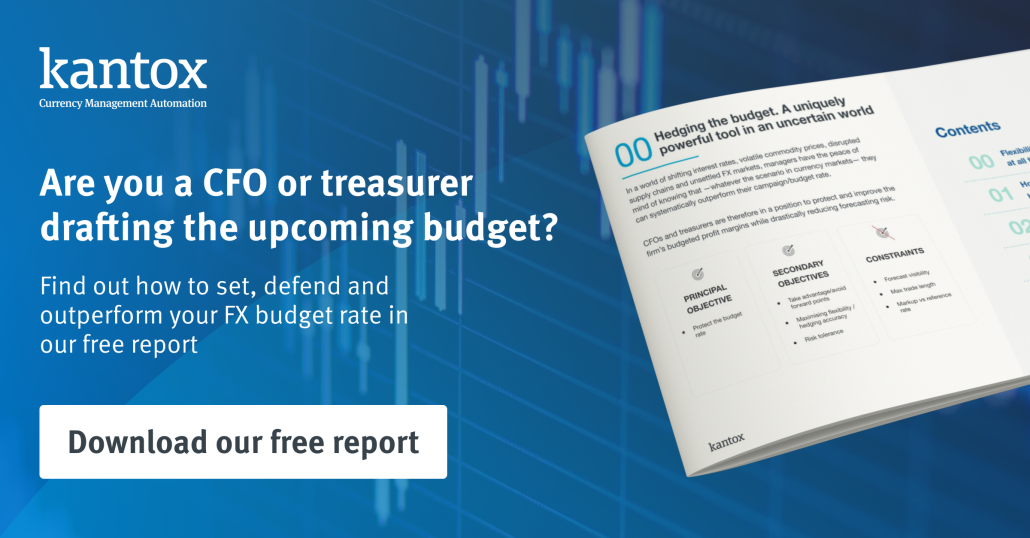Hedging Strategies 101: Layered Hedging
16-01-2023 | treasuryXL | Kantox | LinkedIn |
Avoid the cliff and protect your cash flows! When volatility is at an all-time high, the right currency hedging strategy can set you apart. And save your business from an uncertain future. Transform your FX risk with a layered hedging strategy that will help you withstand unexpected changes in FX markets and protect your margins.
When implementing an FX hedging program, finance professionals responsible for risk management must be aware of the ins and outs of their business. This will be the starting point to uncover potential gaps in the hedging strategy and also opportunities to implement the program that fits perfectly.
Let’s understand how a layered hedging program works and how it could fit with your FX strategy.
Why is a layered hedging strategy important?
Layered hedging programs allow CFOs and Treasurers to handle the related problems of FX markets volatility, shifting interest rate differentials, and less-than-stellar cash flow visibility.
The goal of a layered hedging program is to smooth out the hedge rate over time to lower the variability of company cash flows. Additionally, a layered hedging program that is created from scratch can deal with the problem of forecasting accuracy.
Instead of ‘protecting’ an FX rate, layered hedging programs build the hedge rate in advance. And because hedges are applied in layers, in a progressive manner, you do not need a 100% accurate forecast at all.
Who can benefit from a layered hedging program?
Not all hedging programs are the same, as they tackle different goals for managing FX risk. Before you implement a layered hedging program and start dedicating time and resources, you need to think about certain conditions. These relate to your current business model -including pricing structure, the FX exposure you want to hedge, cash flows, etc.- and your company’s specific needs when it comes to FX hedging.
This type of hedging program is best suited for firms that need or desire to keep steady prices not only for one individual campaign/budget period, but for a set of campaign/budget periods linked together. In layered hedging:
(a) Prices are usually not FX-driven, meaning that the FX rate plays no role in pricing strategy.
(b) The impact of the ‘cliff’ -a sharp adverse fluctuation in currency rates between periods-, cannot be passed on to customers at the onset of a new period.
(c) The exposure to hedge is a rolling cash flow forecast for a set of periods linked together.
Unlike other cash flow hedging programs, like static hedging where prices are either frequently updated or updated at the onset of a new budget period, pricing does not act as a hedging mechanism in layered hedging programs. And that puts cash flows at risk, so a solution must be found elsewhere.
In comes the star of layered hedging, smoothing the rate.
Smoothing the hedge rate over time
The secret of achieving a smooth hedge rate over time is to create commonality between trade dates for a given value date. Take, for example, a 12-month layered hedging program. The value date of October is hedged in 12 different months, from October in the previous year down to September.
Next, the value date of November is hedged in the same manner, starting in November of the previous year down to October. And so on and so forth. Note that the two value dates -October and November- share eleven out of twelve trade dates with the same spot rate. That’s the concept of the mechanically created commonality that lies at the heart of layered hedging programs.
However, the process of ‘layering the hedges’ is not as simple as it may seem at first glance. There are some common challenges that Treasurers and CFOs face when manually performing FX risk management activities.
Common challenges in layered hedging
Before crafting the optimal layered hedging program for your business, there are three common challenges that need to be considered. These are crucial to the success of the FX hedging strategy. And they relate to the configuration of the program, the intrinsic constraints of the business, and the level of automation currently available to the team. Let’s take a closer look.
- Configurations. Depending on risk managers’ secondary objectives, there are many possible configurations for a layered hedging program. Some of these configurations regard:
(1) The degree to which the hedge rate is smoothed, for example by adjusting the programs’ length.
(2) The optimisation of forward points. For example, hedge execution can be delayed if forward points are ‘unfavourable’.
(3) The distance between the average hedge rate and the spot rate.
- Constraints. Each treasury team may face its own set of constraints, some examples include:
(1) The degree of forecast accuracy.
(2) Possible limitations imposed by liquidity providers who might not let a firm trade forward contracts that expire, say, more than two years out.
- Automation. Needless to say, a manually executed layered hedging program can be pretty demanding, especially if many currency pairs are involved. We’ve seen companies running such programs with the help of enormous spreadsheets. This only creates two different operational risks:
(1) Spreadsheet risk, including data input errors, copy & paste errors, formatting and formula errors.
(2) Key person risk, as only a handful of individuals understand the formulas that underpin the ‘monster’ spreadsheets.
Eliminating the uncertainty
Layered hedging programs are a powerful FX risk management tool to face the trifecta of problems created by a highly volatile scenario. These hurdles include currency risk —including the risk of a cliff, as we saw recently with the GBP-USD exchange rate—, shifting interest rate differentials, and less-than-stellar cash flow visibility.
Now that you know the ins and outs of layered hedging, you can start transforming your FX risk management workflow. And forget about the challenges that may come when facing uncertainty. That’s a pretty powerful advantage in a scenario of pandemics, inflation and war!
Optimal hedging strategy with Currency Management Automation
If you want to leave behind the challenges of manual work when it comes to currency risk, consider implementing automation software.
Kantox is the only solution that streamlines the currency management process through powerful automation of the entire FX workflow. This enables businesses to reduce currency risk, protect profit margins and price more competitively.









